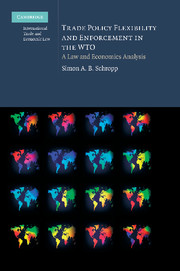Book contents
- Frontmatter
- Contents
- List of figures
- List of abbreviations
- Acknowledgements
- Foreword
- 1 Introduction: trade policy flexibility in the WTO – vice or virtue?
- PART I An introduction to incomplete contracting
- PART II Theorizing about the WTO as an incomplete contract
- 4 Adding context: the WTO as an incomplete contract
- 5 Analyzing the system of non-performance in the WTO
- PART III Flexibility and enforcement in the WTO: towards an agenda for reform
- Bibliography
- Index
4 - Adding context: the WTO as an incomplete contract
Published online by Cambridge University Press: 05 May 2010
- Frontmatter
- Contents
- List of figures
- List of abbreviations
- Acknowledgements
- Foreword
- 1 Introduction: trade policy flexibility in the WTO – vice or virtue?
- PART I An introduction to incomplete contracting
- PART II Theorizing about the WTO as an incomplete contract
- 4 Adding context: the WTO as an incomplete contract
- 5 Analyzing the system of non-performance in the WTO
- PART III Flexibility and enforcement in the WTO: towards an agenda for reform
- Bibliography
- Index
Summary
The WTO emanated from the International Trade Organization (ITO, which never came into existence), as well as from the GATT and its subsequent extensions, which were laid down in codes. The WTO was the outcome of the Uruguay Round (UR) negotiations and came into being on January 1, 1995. It is a single institutional framework organized around various pluri- and multilateral agreements, encompassing the GATT (as modified in the UR), all agreements and arrangements concluded under its auspices in the period between 1947 and 1994, and the complete results of the UR, most notably the GATS, TRIPS, TPRM (‘Trade Policy Review Mechanism’), TRIMs, and DSU. The Marrakech Agreement to Establish the World Trade Organization, or “WTO Agreement” in short, is sometimes referred to as the “Charter” or “Constitution” of the treaty. It is a multilateral contract among sovereign states that establishes the WTO as an international organization and defines various committees, bodies, and councils, as well as the duties of and relationships between these groups.
The WTO is a Member-driven organization with a compact Secretariat. It is mainly a negotiating forum for trade liberalization, a set of legal ground-rules of conduct in international trade, and a venue where signatories can debate and settle their trade disputes. The treaty's prescribed mission and objectives include freer trade, non-discrimination, competitive markets, rule of law, predictability and stability of international trade, and economic development.
In this chapter we wish to thoroughly examine the WTO in detail from a contractual angle.
- Type
- Chapter
- Information
- Trade Policy Flexibility and Enforcement in the WTOA Law and Economics Analysis, pp. 133 - 212Publisher: Cambridge University PressPrint publication year: 2009



